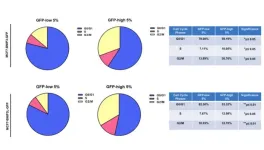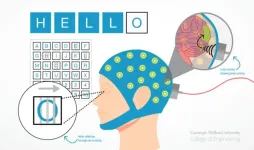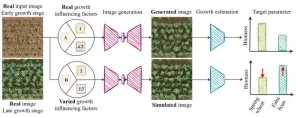(Press-News.org) Potential New Treatment Option for Diabetic Retinopathy
OU researcher developing potential new treatment for diabetic retinopathy that could address the problem much earlier.
OKLAHOMA CITY, OKLA. – Patients with diabetes face a host of potential health problems as they work to manage the chronic disease. Still, one concern that seems to weigh heavily is the risk of losing their sight through a condition known as diabetic retinopathy.
Researchers at the University of Oklahoma Health Sciences and Memorial Sloan Kettering (MSK) Cancer Center are studying a new, revolutionary treatment for diabetic retinopathy that could change the prognosis for these patients. Julia Busik, Ph.D., professor and chair of the department of biochemistry and physiology in collaboration with Richard Kolesnick, MD of MSK Cancer Center, recently published a paper in the journal Cell Metabolism that details how anti-ceramide immunotherapy can address the root cause of the disease and stop progression toward blindness at an earlier stage than previous treatments.
“With the rise in diabetes, there's a rise in complications. One-third of adults over age 40 with diabetes have retinopathy,” said Busik. “If left untreated, diabetic retinopathy can lead to blindness. Losing vision is one of the most feared complications for patients with diabetes.”
This blindness is caused by hemorrhaging lipid, or fatty compound, build-ups. These start as dark spots in the field of view but can, as they multiply, become vision-threatening and eventually cause blindness. There are currently two treatments for diabetic retinopathy, but both have serious health implications and are fairly invasive. One involves lasers that burn the vessels to stop the hemorrhaging; another involves injections directly into the eye that can stop the progression of the disease. According to Busik, these treatments are only sometimes effective.
The researchers are working on an exciting new treatment that could address the root cause of diabetic retinopathy. Continuing research that she began at Michigan State University, Busik has taken a closer look at lipids, specifically lipid pathways in the retina of the eye, and how they are affected by diabetes. She and her team found that a certain, very damaging type of lipid, or ceramide, was present in the eyes of patients with diabetic retinopathy. In turn, they discovered that these ceramides, after stimulation by another type of cell – cytokines – stick together into large domains that cause damaging inflammatory signals to cells in the eye. This causes cell death and the progression of diabetic retinopathy.
In collaboration with the Kolesnick laboratory at MSK Cancer Center, Busik’s team was then able to create an antibody against these lipids to prevent the ceramide buildup from happening and signaling the damage to healthy cells in the retina. The studies show great promise in animal and cell culture models.
Perhaps the most important advance from the current treatment is that it addresses the root cause of the disease, as opposed to late symptoms and stopping progression at the vision-threatening stage, explains Busik. It can also be administered systemically, so it does not have to be injected into the eye. Due to their invasive nature and safety concerns, currently available treatments are only used at very late stages of the disease when the vision is threatened.
“If we have this systemic safe treatment,” said Busik. “It could be given to a patient at a much earlier stage when they are just starting to progress, to make sure that they never get to that late stage.”
About the Project
This research was funded by the NIH grants: R01EY016077 and R01EY030766. This research was also funded, in part, through the NIH/NCI Cancer Center Support Core Grant P30 CA008748. Additional authors of the study include Tim F. Dorweiler, Arjun Singh, Aditya Ganju, Todd A. Lydic, Louis C. Glazer, Richard N Kolesnick. RNK is a founder of Ceramedix Holding LLC. JVB is a consultant for Ceramedix, Inc., subsidiary of Ceramedix Holding LLC. The publication is available at https://doi.org/10.1016/j.cmet.2024.04.013.
About the University of Oklahoma
Founded in 1890, the University of Oklahoma is a public research university located in Norman, Oklahoma. As the state’s flagship university, OU serves the educational, cultural, economic and health care needs of the state, region and nation. OU was named the state’s highest-ranking university in U.S. News & World Report’s most recent Best Colleges list. For more information about the university, visit www.ou.edu.
END
Potential new treatment option for diabetic retinopathy
OU researcher developing potential new treatment for diabetic retinopathy that could address the problem much earlier.
2024-06-17
ELSE PRESS RELEASES FROM THIS DATE:
Paternal use of metformin during sperm production not associated with major birth defects
2024-06-17
Embargoed for release until 5:00 p.m. ET on Monday 17 June 2024
Annals of Internal Medicine Tip Sheet
@Annalsofim
Below please find summaries of new articles that will be published in the next issue of Annals of Internal Medicine. The summaries are not intended to substitute for the full articles as a source of information. This information is under strict embargo and by taking it into possession, media representatives are committing to the terms of the embargo not ...
American diets have a long way to go to achieve health equity
2024-06-17
Poor diet continues to take a toll on American adults. It’s a major risk factor for obesity, type 2 diabetes, cardiovascular disease, and certain cancers, and more than one million Americans die every year from diet-related diseases, according to the Food and Drug Administration. Poor diet and food insecurity is also costly, attributing to an estimated $1.1 trillion in healthcare expenditures and lost productivity. These burdens also contribute to major health disparities by income, education, zip code, race, and ethnicity.
In a study from the Food is Medicine Institute at the Friedman School of Nutrition Science and Policy at Tufts University published today in ...
New ‘aging atlas’ provides a detailed map of how cells and tissues age
2024-06-17
A new aging atlas gives scientists an in-depth view of how individual cells and tissues in worms age and how different lifespan-extending strategies might stop the clock.
Aging impacts all the tissues in our body – from our muscles to our skin. Figuring out how individual tissues and cells age could help researchers better understand the aging process and aid in the development of anti-aging treatments.
Due to their short lifespans, simple body plans, and genetic similarity to humans, many researchers study aging in roundworms. To look at aging at the level of tissues and cells, a team of researchers from HHMI's Janelia ...
New technology allows researchers to precisely, flexibly modulate brain
2024-06-17
By Beth Miller
Human brain diseases, such as Parkinson’s disease, involve damage in more than one region of the brain, requiring technology that could precisely and flexibly address all affected regions simultaneously. Researchers at Washington University in St. Louis have developed a noninvasive technology combining a holographic acoustic device with genetic engineering that allows them to precisely target affected neurons in the brain, creating the potential to precisely modulate selected cell ...
Origins of cumulative culture in human evolution
2024-06-17
Each of us individually is the accumulated product of thousands of generations that have come before us in an unbroken line. Our culture and technology today are also the result of thousands of years of accumulated and remixed cultural knowledge.
But when did our earliest ancestors begin to make connections and start to build on the knowledge of others, setting us apart from other primates? Cumulative culture — the accumulation of technological modifications and improvements over generations — allowed humans to adapt to a diversity of environments and challenges. But, it is unclear when cumulative culture first developed during hominin evolution.
A study published ...
Mitophagy and cancer: BNIP3/BNIP3L’s role in stemness, ATP production, proliferation, and cell migration
2024-06-17
“[...] our current work has provided a novel strategy to enrich for a sub-population of cancer cells, with high basal levels of mitophagy.”
BUFFALO, NY- June 17, 2024 – A new research paper was published on the cover of Aging (listed by MEDLINE/PubMed as "Aging (Albany NY)" and "Aging-US" by Web of Science) Volume 16, Issue 11, entitled, “Mitophagy and cancer: role of BNIP3/BNIP3L as energetic drivers of stemness features, ATP production, proliferation, and cell migration.”
Mitophagy is a selective form of autophagy which permits ...
Breakthrough approach enables bidirectional BCI functionality
2024-06-17
Brain-computer interfaces or BCIs hold immense potential for individuals with a wide range of neurological conditions, but the road to implementation is long and nuanced for both the invasive and noninvasive versions of the technology. Bin He of Carnegie Mellon University is highly driven to improve noninvasive BCIs, and his lab uses an innovative electroencephalogram (EEG) wearable to push the boundaries of what’s possible. For the first time on record, the group successfully integrated a novel focused ultrasound stimulation to realize bidirectional BCI that both encodes and decodes brain waves using machine learning in a study with 25 human subjects. This work opens ...
Polarization and risk perception could play important roles in climate-policy outcomes
2024-06-17
Times of crises often call for strong and rapid action, but in polarized societies, strong top-down policies can backfire.
In a paper published on June 17, 2024, in Environmental Research Letters, SFI Applied Complexity Fellow Saverio Perri, SFI Science Board Fellow Simon Levin (Princeton University), and colleagues present a conceptual model of how these dynamics could play out in efforts to decarbonize our energy supply. The model illustrates the complex interplay between strong policies, people’s perception of risk, and the amount of polarization in a society. They show that in situations where the perception of risk is low — where the ...
AI shows how field crops develop
2024-06-17
Researchers at the University of Bonn have developed software that can simulate the growth of field crops. To do this, they fed thousands of photos from field experiments into a learning algorithm. This enabled the algorithm to learn how to visualize the future development of cultivated plants based on a single initial image. Using the images created during this process, parameters such as leaf area or yield can be estimated accurately. The results have been published in the journal Plant Methods.
Which plants should I combine ...
African research funders in global spotlight through Dimensions indexing project
2024-06-17
African research is receiving a major visibility boost with the indexing of 10 national funders in Dimensions, the world’s largest linked research database.
This project is a collaboration with Digital Science, the Africa PID Alliance (APA), the Association of African Universities (AAU), the Training Centre in Communication (TCC Africa), and the Research Organization Registry (ROR).
“This project connects the research outputs from leading African funding bodies to the global research ecosystem,” said Joy Owango, Executive Director of TCC Africa ...
LAST 30 PRESS RELEASES:
Making lighter work of calculating fluid and heat flow
Normalizing blood sugar can halve heart attack risk
Lowering blood sugar cuts heart attack risk in people with prediabetes
Study links genetic variants to risk of blinding eye disease in premature infants
Non-opioid ‘pain sponge’ therapy halts cartilage degeneration and relieves chronic pain
AI can pick up cultural values by mimicking how kids learn
China’s ecological redlines offer fast track to 30 x 30 global conservation goal
Invisible indoor threats: emerging household contaminants and their growing risks to human health
Adding antibody treatment to chemo boosts outcomes for children with rare cancer
Germline pathogenic variants among women without a history of breast cancer
Tanning beds triple melanoma risk, potentially causing broad DNA damage
Unique bond identified as key to viral infection speed
Indoor tanning makes youthful skin much older on a genetic level
Mouse model sheds new light on the causes and potential solutions to human GI problems linked to muscular dystrophy
The Journal of Nuclear Medicine ahead-of-print tip sheet: December 12, 2025
Smarter tools for peering into the microscopic world
Applications open for funding to conduct research in the Kinsey Institute archives
Global measure underestimates the severity of food insecurity
Child survivors of critical illness are missing out on timely follow up care
Risk-based vs annual breast cancer screening / the WISDOM randomized clinical trial
University of Toronto launches Electric Vehicle Innovation Ontario to accelerate advanced EV technologies and build Canada’s innovation advantage
Early relapse predicts poor outcomes in aggressive blood cancer
American College of Lifestyle Medicine applauds two CMS models aligned with lifestyle medicine practice and reimbursement
Clinical trial finds cannabis use not a barrier to quitting nicotine vaping
Supplemental nutrition assistance program policies and food insecurity
Switching immune cells to “night mode” could limit damage after a heart attack, study suggests
URI-based Global RIghts Project report spotlights continued troubling trends in worldwide inhumane treatment
Neutrophils are less aggressive at night, explaining why nighttime heart attacks cause less damage than daytime events
Menopausal hormone therapy may not pose breast cancer risk for women with BRCA mutations
Mobile health tool may improve quality of life for adolescent and young adult breast cancer survivors
[Press-News.org] Potential new treatment option for diabetic retinopathyOU researcher developing potential new treatment for diabetic retinopathy that could address the problem much earlier.




